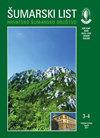Determining the fire season by analyzing climatic conditions in northeastern Serbia
IF 0.4
4区 农林科学
Q4 FORESTRY
引用次数: 0
Abstract
The territory of Serbia is sensitive to forest fires, which endanger various systems and play an important role in shaping the ecosystem. The probability of the occurrence and spread of forest fires in the area of northeastern Serbia was examined, depending on the influence of climatic conditions. Changes in climatic conditions are investigated at the annual and monthly level of air temperature, precipitation and air humidity values recorded at three main meteorological stations (Zaječar, Negotin, Crni Vrh) in the area of northeastern Serbia. Changes in climatic conditions in the period 2009-2022 compared to the period 1961-1990 were analyzed, with an emphasis on 2012 and 2014. The length of the average fire season was determined through a modified version of Thornthwaite’s evapotranspiration index. The fire season is longer in the area of Negotin and Zaječar than in the area of Crni Vrh. On the basis of the monthly humidity indices, a significantly longer fire season was determined in 2012 compared to 2014, as well as the multi-year period 1961-1990.An analysis of the value of the Burning Index (B) for the period 2009-2022 was performed and a correlation was established with the data on the number of forest fires. The burning index in the area of northeastern Serbia is the highest during the months of July, August and September. Significantly higher values of the burning index are for 2012 compared to 2014, which is correlated with the occurrence of forest fires in this period.通过分析塞尔维亚东北部的气候条件来确定火灾季节
塞尔维亚的领土对森林火灾很敏感,森林火灾危及各种系统,并在形成生态系统方面发挥重要作用。根据气候条件的影响,研究了塞尔维亚东北部地区发生和蔓延森林火灾的可能性。气候条件的变化是根据塞尔维亚东北部地区三个主要气象站(扎耶阿尔、涅戈廷、Crni Vrh)每年和每月记录的气温、降水和空气湿度值进行调查的。分析了2009-2022年与1961-1990年的气候条件变化,重点分析了2012年和2014年的气候条件变化。平均火灾季节的长度是通过修改版本的Thornthwaite的蒸散指数确定的。涅戈廷和扎耶尔地区的火灾季节比Crni Vrh地区要长。基于月湿度指数,2012年的火灾季节明显长于2014年,1961-1990年为多年期。对2009-2022年期间的燃烧指数(B)值进行了分析,并与森林火灾数量数据建立了相关性。塞尔维亚东北部地区的燃烧指数在7月、8月和9月最高。2012年的燃烧指数明显高于2014年,这与该时期森林火灾的发生有关。
本文章由计算机程序翻译,如有差异,请以英文原文为准。
求助全文
约1分钟内获得全文
求助全文
来源期刊

Sumarski List
FORESTRY-
CiteScore
0.90
自引率
20.00%
发文量
32
审稿时长
>12 weeks
期刊介绍:
Forestry Journal publishes scientific and specialist articles from the fields of forestry, forestry-related scientific branches, nature protection and wildlife management.
 求助内容:
求助内容: 应助结果提醒方式:
应助结果提醒方式:


